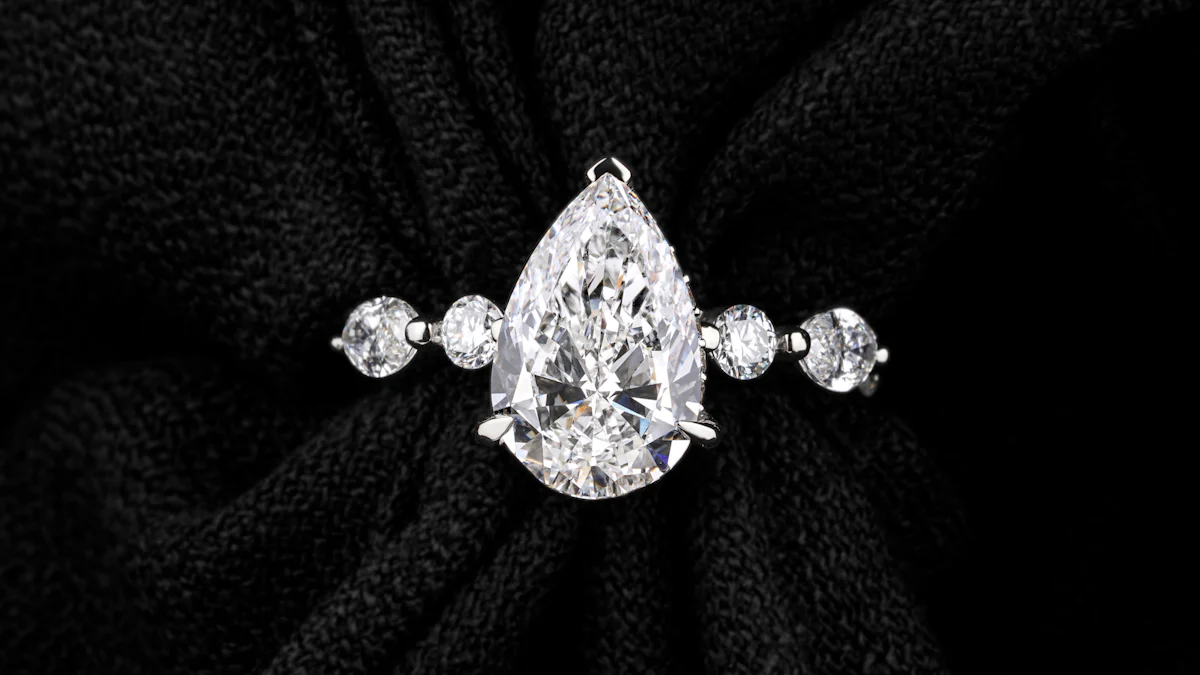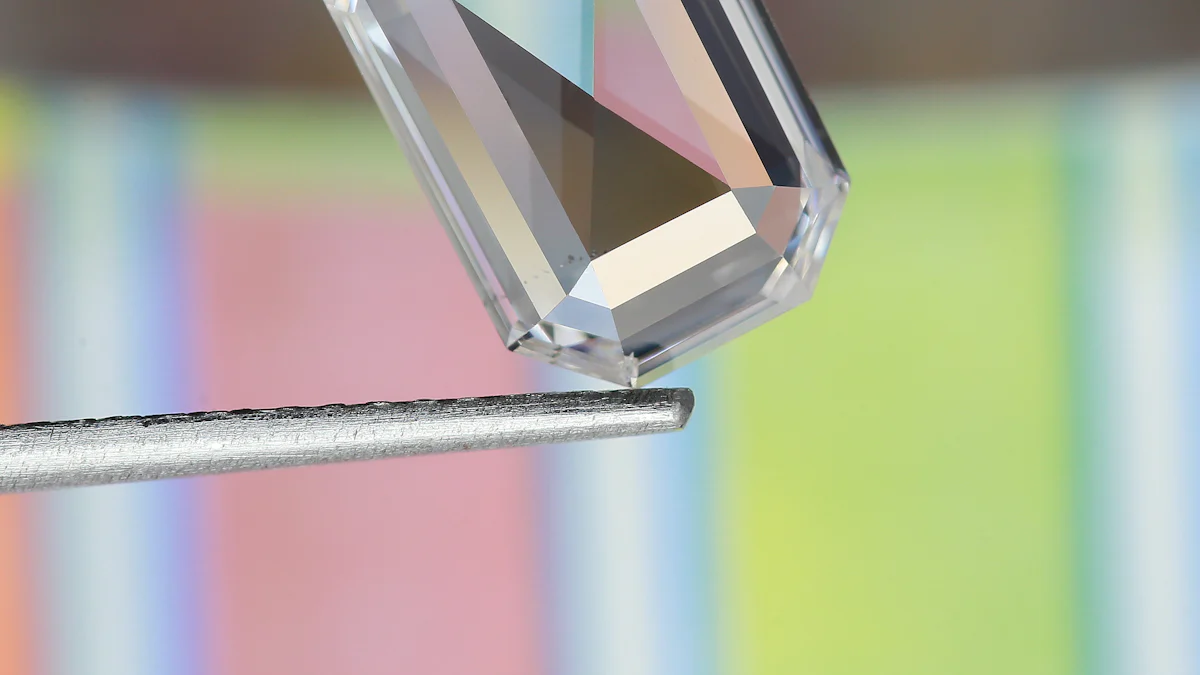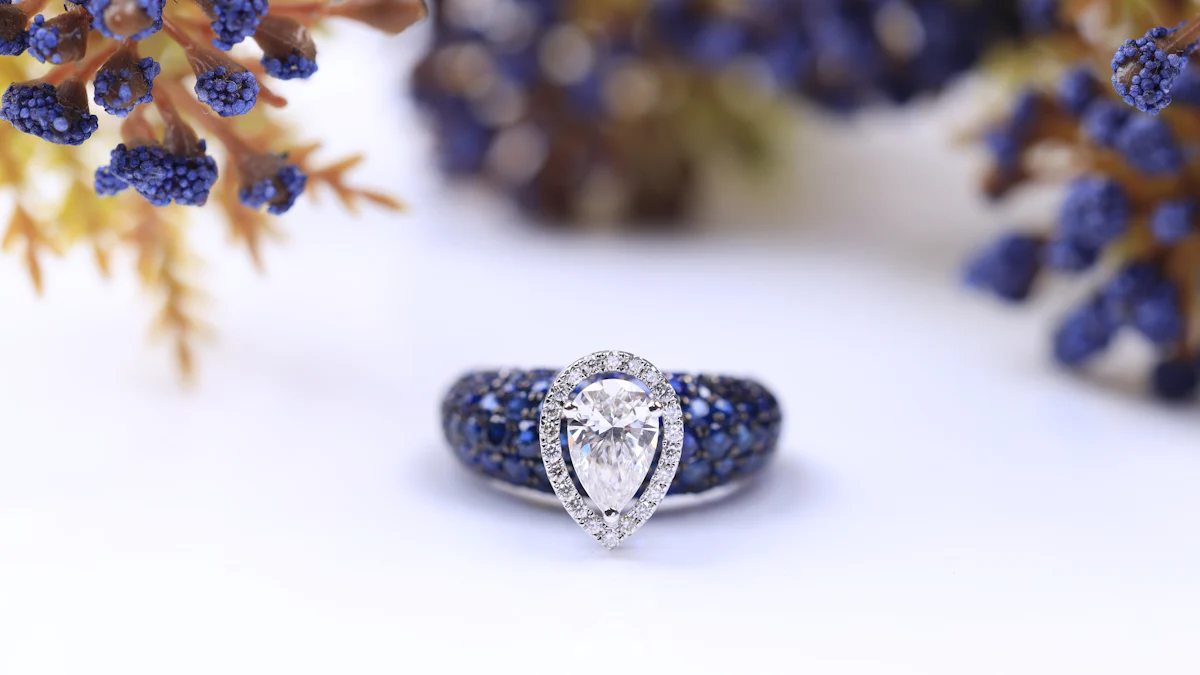Diamond Carat Size Comparison Made Simple

Visualizing how a diamond looks on your hand can make choosing the perfect one much easier. A diamond’s carat weight doesn’t just affect its price—it also influences how it appears on your finger. Tools like a diamond carat size comparison chart or try-on apps let you see how different sizes might suit you. Your hand’s proportions play a big role too. A diamond that looks large on one person may seem smaller on another. Comparing sizes in person or using visual guides ensures you pick a diamond that feels just right for your hand.
What is Diamond Carat Size?
When you hear the term "diamond carat size," you might think it refers to how big a diamond looks. However, that’s not entirely accurate. Understanding what carat size truly means can help you make better decisions when choosing a diamond.
Understanding Diamond Size Measurement
Diamonds are measured in carats, but this doesn’t directly translate to their physical size. A carat is a unit of weight, equal to 0.2 grams. While weight plays a role in how large a diamond appears, other factors like shape and cut significantly influence its visual size. For example, a round diamond and an oval diamond of the same carat weight may look different in size due to their proportions.
To get a clearer picture, tools like a diamond carat size chart are incredibly helpful. These charts show you how diamonds of various carat weights typically measure in millimeters. They’re a great way to visualize how a diamond might look in a piece of jewelry. If you’re shopping online or in-store, referring to such a chart can save you from guessing.
Carat as a Measure of Weight, Not Dimensions
It’s important to remember that carat measures weight, not dimensions. Two diamonds with the same carat weight can have different diameters depending on their cut. A well-cut diamond maximizes light performance, making it appear larger and more brilliant. On the other hand, a poorly cut diamond may look smaller even if it weighs the same.
For instance, a 1-carat diamond typically measures around 6.4mm in diameter, but this can vary. The cut quality determines how much of the diamond’s weight is visible from the top. This is why jewelers often emphasize cut alongside carat weight when discussing diamond size in jewelry.
Common Misconceptions About Diamond Carat Size
There are several common misconceptions about diamond carat size that can lead to confusion. One of the biggest is assuming that a higher carat weight always means a larger-looking diamond. As mentioned earlier, the cut and shape of the diamond play a huge role in its perceived size. A shallow-cut diamond may look bigger but lack brilliance, while a deep-cut diamond may appear smaller but sparkle more.
Another misconception is that carat weight directly correlates with value. While carat weight does impact price, other factors like color, clarity, and cut are equally important. A smaller diamond with excellent cut and clarity can often outshine a larger diamond with poor quality.
Lastly, many people believe that a diamond will look the same on every hand. In reality, the size of your fingers and the setting of the ring can change how the diamond appears. This is why trying on diamonds or using visualization tools like a diamond carat size chart is so valuable.
“Carat weight does not necessarily denote size; two diamonds of the same carat weight can vary in size based on cut and shape.” – Research on Carat Weight and Diamond Size Perception
By understanding these nuances, you can avoid falling for these misconceptions and focus on finding a diamond that truly suits your style and preferences.
How Carat Size Appears on Different Hand Sizes

Choosing the right diamond isn’t just about its weight or price. The way a diamond looks on your hand can make all the difference. Let’s explore how the relationship between diamond carat and hand size affects the overall appearance and how you can find the perfect match.
Matching Diamond Carat to Hand Size
The size of your hand plays a big role in how a diamond appears. A smaller hand can make a diamond look larger, while a bigger hand might make the same diamond seem smaller. For example, a 1-carat diamond may look bold and prominent on petite fingers but appear more subtle on larger hands. This is why matching diamond carat to hand size is so important when making your choice.
If you’re unsure where to start, consider popular diamond sizes. Diamonds ranging from 0.25 carats (about 4mm) to 2 carats (around 8mm) are common choices. A 0.7-carat diamond often strikes a balance between size and affordability, making it a great option for many buyers. Keep in mind that the visual size of diamonds can vary depending on their cut and shape, so always take these factors into account.
“A diamond will look bigger when worn on a small hand, making carat weight appear more significant.” – Jewelry Design Insights
By understanding this relationship, you can choose a diamond that complements your hand size and enhances its beauty.
The Role of Finger Shape in Perceived Diamond Size
Your finger shape also influences how a diamond looks. Long, slender fingers tend to make diamonds appear larger, while shorter or wider fingers can make the same diamond seem smaller. This is where the perceived carat weight comes into play. A diamond’s cut and shape can either enhance or diminish its visual impact on your finger.
For instance, elongated shapes like oval or marquise diamonds create the illusion of length, making them ideal for shorter fingers. Round diamonds, on the other hand, offer a classic look that suits most finger shapes. The impact of shape on visual size is something you shouldn’t overlook when selecting your diamond.
If you’re trying to maximize the diamond visual size, consider how the diamond shape interacts with your finger proportions. Experimenting with different shapes can help you find the one that feels just right.
How Ring Settings Influence Diamond Carat Size Comparison
The ring setting can dramatically change how a diamond looks on your hand. Certain settings, like halo or bezel, can make a diamond appear larger by adding extra sparkle or framing the stone. On the flip side, minimalist settings may highlight the diamond’s true size without any added embellishments.
When comparing diamonds of different carat weights, pay attention to how they look in various settings. A well-chosen setting can enhance the diamond’s brilliance and make it stand out on your hand. For example, a solitaire setting focuses all attention on the diamond, while a pavé band adds extra shimmer that complements the stone.
The impact of cut on size perception also ties into this. A well-cut diamond reflects light beautifully, making it appear larger and more brilliant. This is why jewelers often emphasize cut quality when discussing diamond carat size comparison.
By considering your hand size, finger shape, and the ring setting, you can confidently choose a diamond that looks stunning and feels perfect for you.
Tools and Methods for Diamond Carat Size Comparison

When it comes to choosing the perfect diamond, having the right tools and methods can make all the difference. These resources help you visualize how different carat sizes will look, ensuring you make a confident and informed decision. Let’s explore some of the most effective ways to compare diamond carat sizes.
Using a Diamond Carat Size Chart
A diamond carat size chart is one of the most straightforward tools you can use. It provides a visual representation of how diamonds of various carat weights measure in millimeters. This makes it easier to understand the relationship between carat weight and the actual size of the diamond.
For example, a 1-carat diamond typically measures around 6.4mm in diameter, but this can vary depending on the cut and shape. A chart helps you see these differences clearly. Whether you’re shopping online or in-store, referring to a diamond carat size chart ensures you don’t have to rely on guesswork.
“This handy diamond carat weight chart can help you visualize both carats and points.” – Diamond Carat Weight Chart
If you’re new to diamonds, using a diamond carat size chart can simplify the process. It’s especially helpful when comparing diamonds of the same carat weight but different shapes, like round versus oval. By understanding these measurements, you’ll feel more confident in your choice.
Benefits of Online Visualization Tools
Online visualization tools take the guesswork out of shopping for diamonds. These tools let you see how a diamond will look on your hand or in a specific ring setting. For instance, platforms like the Diamond Database feature simulators that allow you to compare the visual size of diamonds on actual-sized rings and fingers.
These tools are perfect if you’re shopping from home. You can experiment with different carat weights, shapes, and settings without stepping into a store. Many tools also include interactive features, like zooming in on the diamond or rotating it to view it from different angles.
“The Diamond Database is a platform for comparing and learning about diamond shapes and sizes. It features a diamond ring simulator where you can compare actual diamond sizes on an actual sized ring and finger.”
Using these tools saves time and helps you narrow down your options before visiting a jeweler. They’re also great for exploring how different carat sizes fit your style and budget.
In-Person Comparisons at Jewelers
While charts and online tools are incredibly useful, nothing beats seeing diamonds in person. Visiting a jeweler allows you to try on different diamonds and see how they look on your hand. This hands-on experience is invaluable for understanding how carat size, shape, and setting work together.
When you’re at a jeweler, ask to see diamonds of various carat weights side by side. Pay attention to how the cut and shape affect their appearance. For example, an oval diamond may look larger than a round diamond of the same carat weight due to its elongated shape.
“Rather than getting stuck on a number for carat weight, focus on what you like about a diamond, what looks best on your hand, and what style of setting you’d like to use.” – Choosing the Right Diamond
In-person comparisons also give you the chance to evaluate the diamond’s brilliance and sparkle under different lighting conditions. This ensures you choose a diamond that not only looks great on paper but also shines beautifully in real life.
By combining these tools and methods—charts, online visualization tools, and in-person comparisons—you’ll have everything you need to find the perfect diamond. Each approach offers unique benefits, so using them together will give you the most comprehensive understanding of diamond carat sizes.
Tips for Choosing the Right Diamond Carat Size for You
Choosing the perfect diamond carat size can feel overwhelming, but focusing on what matters most to you makes the process much easier. Let’s break it down into simple steps to help you find a diamond that fits your style, budget, and comfort.
Balancing Personal Style and Budget
Your diamond should reflect your personal style while staying within your budget. Start by thinking about what you love most in a diamond. Do you prefer a bold, eye-catching look or something more subtle and timeless? Your preferences will guide you toward the right size.
Budget plays a big role too. Larger diamonds often come with higher price tags, but that doesn’t mean you need to compromise on beauty. A smaller diamond with an excellent cut can sparkle just as brilliantly as a larger one. Focus on quality over size if you’re working with a tighter budget.
“An excellent cut diamond can provide more sparkle than a larger diamond with a poor cut.”
Remember, it’s not about choosing the biggest diamond—it’s about finding one that feels perfect for you. Balancing your style and budget ensures you’ll love your diamond for years to come.
Matching Diamond Carat to Hand Size and Proportions
The relationship between diamond carat and hand size is key to how your diamond will look when worn. A diamond that looks large on one person might appear smaller on someone else. Smaller hands can make a diamond seem bigger, while larger hands may require a slightly larger carat size for the same visual impact.
For example, a 1-carat diamond might look bold and prominent on petite fingers but appear more understated on larger hands. Consider how the diamond complements your hand proportions. If you’re unsure, try on different sizes to see what feels right.
“A diamond will look bigger when worn on a small hand, making carat weight appear more significant.”
Shapes also matter. Elongated shapes like oval or marquise diamonds can create the illusion of length, making them ideal for shorter fingers. Round diamonds, on the other hand, offer a classic look that suits most hand shapes. By understanding the relationship between diamond carat and hand size, you can choose a diamond that enhances your natural beauty.
Considering Comfort and Wearability
Comfort is just as important as appearance. A diamond that feels too heavy or bulky might not be practical for everyday wear. Think about your lifestyle and how often you’ll wear the ring. If you have an active job or hobbies, a smaller diamond might be more comfortable and less likely to snag.
The ring setting also affects wearability. Certain settings, like halo or bezel, can make a diamond appear larger without adding extra weight. Minimalist settings highlight the diamond’s true size and keep the design sleek and comfortable.
“Focus on what you like about a diamond, what looks best on your hand, and the style of setting rather than getting stuck on a specific carat weight.”
Ultimately, your diamond should feel like an extension of you. It should fit your lifestyle, match your hand proportions, and reflect your personal style. By considering these factors, you’ll find a diamond that looks stunning and feels just right.
Understanding diamond carat size as a weight measurement helps you make smarter choices. It’s not just about the weight; the visual size of diamonds depends on factors like cut and shape, which influence how they appear on your hand. Tools such as a diamond carat size chart, try-on apps, and in-person comparisons simplify the decision-making process. These resources let you see how different sizes fit your hand and style. By balancing your personal preferences, hand proportions, and budget, you can confidently select a diamond that feels perfect for you.
FAQ
What does carat size mean in diamonds?
Carat size refers to the weight of a diamond, not its physical dimensions or diameter. One carat equals 0.2 grams. While carat weight influences a diamond's size, factors like cut and shape also play a big role in how large the diamond appears.
How does carat size affect the cost of a diamond?
Carat size significantly impacts a diamond's price. Larger carat weights often come with higher costs because bigger diamonds are rarer. However, other factors like cut, clarity, and color also influence the price. A smaller diamond with excellent cut quality can sometimes outshine a larger one with lower quality.
Does a higher carat weight always mean a bigger-looking diamond?
Not necessarily. Carat weight measures the diamond's weight, not its size. Two diamonds with the same carat weight can look different depending on their cut and shape. For example, an oval diamond may appear larger than a round diamond of the same carat weight due to its elongated shape.
How should I balance carat size with my budget?
Start by deciding what matters most to you—size, sparkle, or overall quality. If you're on a budget, focus on cut quality rather than just carat weight. A well-cut diamond will reflect light beautifully, making it appear larger and more brilliant, even if it’s smaller in carat weight.
Why is carat weight important when buying a diamond?
Carat weight helps you understand the diamond's size and value. It’s a key factor in choosing the perfect piece of jewelry, whether it’s an engagement ring, earrings, or a pendant. Knowing the carat weight also helps you compare diamonds and make an informed decision.
What’s the difference between carat weight and millimeter measurements?
Carat weight measures the diamond's weight, while millimeter measurements show its physical dimensions. A diamond's cut and shape can affect how its weight is distributed, so it’s helpful to consider both carat weight and millimeter size when evaluating diamonds.
How does carat size influence the appearance of a diamond on your hand?
Carat size can look different depending on your hand size and finger shape. A smaller hand can make a diamond appear larger, while a larger hand might make the same diamond seem smaller. Trying on diamonds or using visualization tools can help you see how carat size looks on your hand.
What’s a pro tip for understanding carat weight?
Remember, carat weight doesn’t directly translate to size. A diamond’s cut and shape can make it look bigger or smaller than its actual weight. Always consider the diamond’s proportions and how it appears in person or through visualization tools.
Are diamonds always evaluated by carat weight?
Carat weight is one of the most common ways to evaluate diamonds, but it’s not the only factor. Millimeter measurements, cut quality, and shape also play a big role in determining a diamond’s appearance and value. Don’t rely solely on carat weight when making your choice.
How can I choose the right carat size for me?
Think about your personal style, hand proportions, and lifestyle. If you prefer a bold look, go for a larger carat size. If comfort and practicality matter more, a smaller diamond with excellent cut quality might be a better fit. Use tools like carat size charts and try-on apps to find the perfect match.
See Also
Comparing Prices of All Around Diamond Rings
A Guide to Diamond Cuts for Engagement Rings
What is the Size of a 2.25 Carat Diamond

